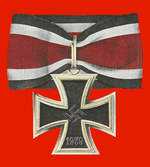Heinz Schweizer
| Heinz Schweizer | |
|---|---|
| Born |
18 July 1908 Berlin |
| Died |
5 June 1946 (aged 37) Klobbicke/Biesenthal |
| Allegiance |
|
| Service/branch |
|
| Rank | Hauptmann |
| Unit | Führer Sprengkommando der Luftwaffe I/IV Ratingen/Düsseldorf |
| Battles/wars | World War II |
| Awards | Knight's Cross of the Iron Cross |
Hauptmann Heinz Schweizer (18 July 1908 – 5 June 1946) was a Luftwaffe Feuerwerker or armourer, specifically a bomb disposal operator, during World War II.
He is noted for his role in saving a group of political prisoners at the end of the war.[1]
Most German bomb disposal during World War II was carried out by the Luftwaffe. Feuerwerker or armourers were given specific and extensive training in bomb disposal,[2] although by the late-war period this was replaced by experience and examination alone, as for the British system. A bomb disposal section or Sprengkommando was led by an officer or Oberfeuerwerker (Senior NCO) with three or four Feuerwerker. Simple labouring, such as excavation for buried bombs, was carried out by prisoners: either criminals or political prisoners, but not prisoners of war. Citizens of occupied countries were also used, within those countries. These prisoner labourers were in turn guarded by Luftwaffe guards. Relations between Luftwaffe members and prisoners appear to have been cordial,[2] for the political prisoners at least, if not the criminals.
In May 1943 Schweizer recovered an unexploded bouncing bomb from a plane that crashed on its way to the target during Operation Chastise, the Dambuster raid.[3]
On 28 June 1943 he was awarded his Ritterkreuz des Eisernen Kreuzes (Knight's Cross of the Iron Cross) as Hauptmann (W)[Notes 1] and leader of Sprengkommando 1/IV Ratingen-Düsseldorf.[5][6]
In 1945, Hauptmann Schweizer learned that the SS were about to execute a number of political prisoners. Together with his junior assistant, army officer Oberleutnant Werdelmann, he went to their camp. Claiming that a number of unexploded bombs required an immediate large team of labourers, he had the threatened prisoners released to his own custody. He took them to his headquarters at Kalkum in the Ruhr until they could be released to the advancing American Army.[1]
Schweizer was murdered on 5 June 1946 in Klobbicke/Biesenthal.[7]
Notes
References
- ↑ 1.0 1.1 Hogben, Arthur, Major (1987). Designed to Kill. Patrick Stephens Limited. p. 261. ISBN 0-85059-865-6.
- ↑ 2.0 2.1 Hogben, 1987, Annex D, German bomb disposal, pp. 258–260
- ↑ Jasper Copping (5 May 2013). "New German plaque for downed Dambuster bomber". Daily Telegraph. Retrieved 13 May 2013.
- ↑ Fellgiebel 2000, p. 29
- ↑ Fellgiebel 2000, p. 396
- ↑ "Heinz Schweizer (photograph)". 3 March 2006.
- ↑ Scherzer 2007, p. 697
- Bibliography
- Fellgiebel, Walther-Peer (2000). Die Träger des Ritterkreuzes des Eisernen Kreuzes 1939–1945 – Die Inhaber der höchsten Auszeichnung des Zweiten Weltkrieges aller Wehrmachtteile [The Bearers of the Knight's Cross of the Iron Cross 1939–1945 — The Owners of the Highest Award of the Second World War of all Wehrmacht Branches] (in German). Friedberg, Germany: Podzun-Pallas. ISBN 978-3-7909-0284-6.
- Scherzer, Veit (2007). Ritterkreuzträger 1939–1945 Die Inhaber des Ritterkreuzes des Eisernen Kreuzes 1939 von Heer, Luftwaffe, Kriegsmarine, Waffen-SS, Volkssturm sowie mit Deutschland verbündeter Streitkräfte nach den Unterlagen des Bundesarchives (in German). Jena, Germany: Scherzers Militaer-Verlag. ISBN 978-3-938845-17-2.
- Thamm, August (2004). Hauptmann (W) und Ritterkreuzträger Heinz Schweizer—Feuerwerker und Sprengkommandoführer (in German). Biblio-Verlag. ISBN 3-7648-2660-6.
| |||||||||||||
